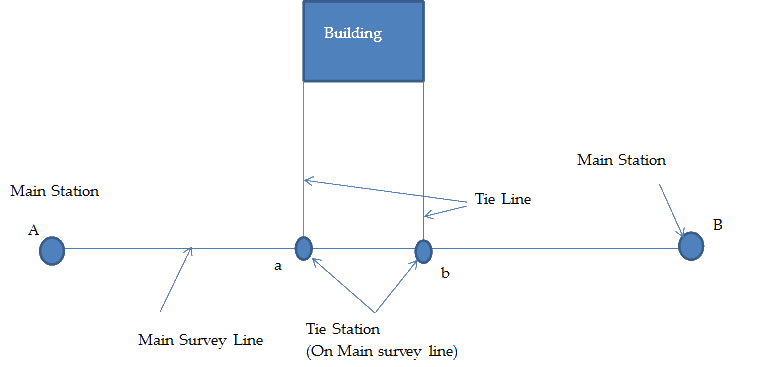Definition
Survey Stations is a point of importance at the beginning and end of chain line. There are two types of survey stations:
Main Station
- These are the end of survey line i.e. which connects boundaries.
- Line joining Main Stations is called Main Survey Line or Chain Line.
- They are represented by Circle, Capital letters A B... Or number 1 2... Or (A)
Subsidiary or Tie Station
- These are the points selected on main line, where it is necessary to run auxiliary lines to locate interior details such as corner, tree, building etc.
- Lines joining tie station are called Tie Lines or Subsidiary Lines
- They are represented by Small letters a, b,

Selection of Survey Station
The following points should be kept in mind while selecting a station:
- The stations should be mutually inter-visible
- Main principle of chain survey should strictly be observed
- If possible, line through the whole length of area should be drawn
- All triangles should be well defined
- A check line should be provided in each triangle
- Survey lines should be as few as possible
- A number of tie lines should be drawn
- Position of survey lines should be such that to avoid obstacles to chaining and ranging
- It should be on level ground
- The sides of triangle should pass as close to the boundary as possible.
Important Lines
- Base line
- Check line
- Tie line
Also See: Types of Surveying Chains
Base Line
- The longest of the chain lines used in making a survey is generally regarded as Base line.
- It is the most important line because it fixes up the direction of all other lines, since on base line, is built framework of a survey.
- It should be laid on level ground, as possible through the center and length of the area.
- It should be correctly measured and should be measured twice or thrice.
Check Line
- A check line also called proof line is a line joining the apex of a triangle to some fixed point on the opposite side.
- A check line is measured to check the accuracy of the framework.
- Thus there is a complete check on the field measurement as well as on the accuracy of the plotting work.
Tie Line
- A tie line is a line joining fixed points termed as Tie station on the main survey lines.
- A tie line usually fulfill a dual purpose i.e. it checks the accuracy of the framework and enables the surveyor to locate the interior details which are far away from the main chain line


